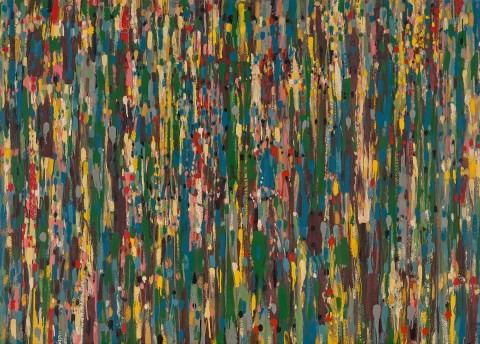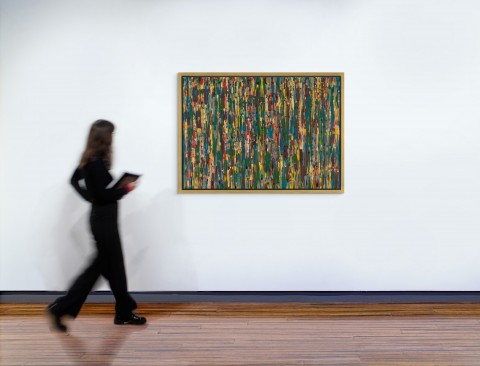NON-OBJECTIVE PAINTING, 1964
RALPH BALSON
oil and synthetic enamel on composition board
98.5 x 137.5 cm
Gallery A, Sydney (label attached verso)
Ann Lewis AO, Sydney (label attached to backing verso)
The Estate of Ann Lewis AO, Mossgreen, Sydney, 7 November 2011, lot 125
Private collection, Perth, acquired from the above
Bonhams, Sydney, 16 June 2015, lot 6
John Barnes, Melbourne, acquired from the above
The Estate of John Barnes, Melbourne
Paintings by the late Ralph Balson, 1960 – 64: The third and final Memorial Exhibition, Gallery A, Sydney, 27 May – 14 June 1969; Gallery A, Melbourne, 8 – 25 July 1969, cat. 35
Ralph Balson: A Retrospective, Heide Park and Art Gallery, Melbourne, 15 August – 24 September 1989; and touring to Newcastle Region Art Gallery, New South Wales, 6 October – 19 November 1989, Wollongong City Gallery, New South Wales, 1 December 1989 – 28 January 1990, Art Gallery of New South Wales, Sydney, 14 February – 1 April 1990, and University Art Museum, Brisbane, 12 April – 24 May 1990, cat. 60
Adams, B., Ralph Balson: A Retrospective, exhibition catalogue, Heide Park and Art Gallery, Victoria, 1989, cat. 60, pp. 35, 89, 97 (illus.)
Throughout his career, Ralph Balson tirelessly sought a process of abstract painting that would respect the physical qualities of paint while illustrating what he would call the ‘ineffable’: the sublime and invisible forces of the universe.1 This pursuit led him through a disciplined, logical progression of different styles of abstract painting – from the planar geometry of his ‘Constructive’ works, to painterly fragmentation in the ‘Non-Objective’ paintings, and finally, the poured ‘Matter Paintings’. In the early 1950s, the first of these tipping points, Balson released himself from the impersonal and serene rigour of his constructivism and allowed himself to embrace the ever-changing fluidity of the universe. His new style of lyrical and painterly abstraction was one that Daniel Thomas qualified as the ‘climax of his career’, created at precisely the time when Romantic abstraction became fashionable in the circles of Contemporary art in Sydney.2
The present Non-Objective Painting, 1954 represents a vision of the infinite through a complex and vibrant kaleidoscope of layered staccato marks. With a variety of vertical brushstrokes, Balson has distributed the colours throughout this composition with the utmost care, associating unexpected colour variations to create a delicate vibrating motion. With no clear focal point, the eye is drawn around the painting, attracted by joyful and bold tonal associations, such as stippled highlights of soft pink, yellow and cadmium red, over daubs of green and cobalt blue. Non-Objective Painting is a superb example of Balson’s increasingly gestural, impressionist interpretation of the underlying fabric of the universe.
Significantly, Non-Objective Painting was created at a pivotal point in Balson’s career. While he remained for most of his life a quiet man removed from the social scene of the Sydney art world, it was in 1953 that Balson finally started to receive a solid critical reception. Not only did the Art Gallery of New South Wales acquire one of his Constructive Paintings for their permanent collection, but the Conference of Interstate Gallery Directors (a meeting of the directors of Australia’s major art museums) selected two of his paintings, both from the 1950s, to be included in a major diplomatic exhibition in London of the best contemporary Australian Art, Twelve Australian Artists, alongside established artists Russell Drysdale, Sidney Nolan and Arthur Boyd.3
1. Adams, B., ‘Metaphors of Scientific Idealism: The theoretical background to the paintings of Ralph Balson’ in Bradley, A. and Smith, T. (eds), Australian Art and Architecture: Essays presented to Bernard Smith, Oxford University Press, Melbourne, 1980, p. 188
2. Thomas, D., ‘Ralph Balson’, Art and Australia, vol. 2, no. 4, March 1965, p. 257
3. Thomas, D., ‘Ralph Balson and Gallery A’, Gallery A Sydney 1964 – 1983, Campbelltown Arts Centre, New South Wales, 2009, p.106
LUCIE REEVES SMITH


